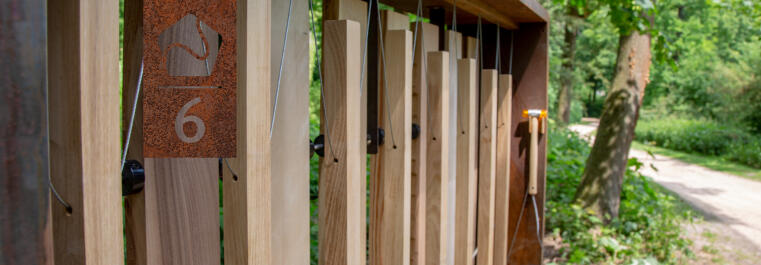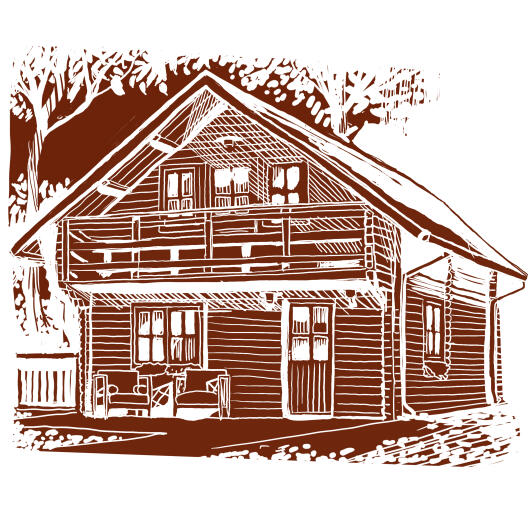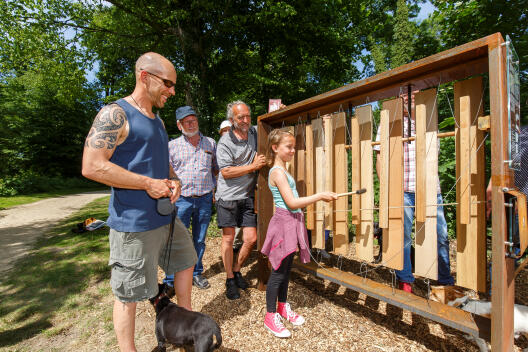

WOOD: A RAW MATERIAL, FROM PAPER TO XYLOPHONE

Wood from a variety of tree types can be used for many different things. Furniture, flooring, musical instruments, houses or paper – all of these can be made from wood. As can other things which we can hardly imagine living without in our daily lives – coffee filters and teabags, for example. This explains why wood is one of most traded raw materials. Although trees grow again, this growth takes a long time – depending on the type of tree. This is why the idea of sustainability is important: for every tree which is felled, a new one should be planted. For more than 200 years now, this has been the principle underlying forest management in Germany.
What does sustainability mean exactly? Sustainable action means that we do not harm the environment, and that we behave in such a way that all living things, and future generations too, have a good life on our Earth. Each and every one of us can make a contribution. Pay attention to the environment around you every day and help to protect it!

Musical Instruments
Some of the wood collected from sustainable forests in Germany is used to build instruments, such as violins and guitars. When you listen to their sound, you are hearing the vibrations reverberating through the sound board. Different types of wood are used for building different instruments. For example, the wood used for lathing flutes, oboes and clarinets is very different from that used in violins, guitars and pianos. The violin maker, for instance, prefers high-quality spruce for the sound board, maple for the body and extremely robust hardwood (e.g. boxwood or ebony) for the tailpiece, fingerboard and the pegs. Spruce is also the wood of choice for the sound boards in pianos, harpsichords and spinets. Only a frame made of hard oak can withstand the enormous tension of the many strings (up to 20 tons!). The best tone woods are usually the ones with “tight year rings”, i.e. wood from trees which grow very slowly.
There are also many sounds in the Schlosspark – leaves rustling, branches cracking, birds chirping. Sometimes it’s loud and sometimes it’s quiet, sometimes the pitch is high and sometimes it’s low.
The xylophone – an »idiophone«!
All of a sudden, a heavy branch snaps in a gust of wind and falls onto the branches below. When wood knocks against wood, it can make many different sounds. And when the tall trees sway back and forth in a storm, you can hear how they creak and groan.
Depending on its composition, wood produces sound that can be higher or lower, louder or softer, and differ in tone and resonance. When you toss a piece of split firewood onto a pile, listen very carefully. Each piece makes a slightly different sound when it strikes the pile. And if you have a very good ear, you’ll be able to tell by its sound whether the piece was short or long, thick or slender, heavy or light. You might even be able to discern whether it was made of spruce, beech or fruit tree. This discovery and the joy of making sounds is what led humans to invent the xylophone – in Africa, Asia, Europe, in prehistoric times and any place where wood is used.
Xylophones belong to the class of instruments called “idiophones” which means they are made of a material that vibrates when struck and emits sound. In the xylophones you’ve seen at school, wooden bars are placed across an open wooden case. If you touch the case while playing, you’ll notice it vibrates. This vibration, which we call resonance, amplifies the sound.

How our xylophone works
Our xylophone consists of eight wooden bars arranged in a row, each approximately equal in length and made of different kinds of wood from our region. The result is a fascinating and completely new “musical scale”. Not only do the bars produce sounds at different pitches, but also different tones which is largely the result of their growth composition. You can see how much they vary in colour and grain. With your fingers you can feel their different qualities – smooth or rough, hard or soft, cool or warm, light or heavy. And if you carefully strike them with the mallet – or even better, knock with your knuckles – you can hear their very unique sound which mysteriously changes depending on where you knock. In the second row, you will find eight more wooden bars. These are made of the same type of wood but are cut at varying lengths. Here you can discover how the different lengths affect the pitch.
WHAT'S THE ANSWER?
1. Guess how many people work in forest management and the wood industry in Germany
2. Why do you think the wooden xylophone has different tones?
3. Where do you find wood being used in your everyday lives?
4. How can paper be “wood-free”?
SOLVING:
1. Around 1.2 million. That’s roughly equivalent to the population of Cologne, the fourth largest city in Germany.
2. The tones depend on the type of wood used, and on the diameter and length of the wooden bars.
3. Have a look around at home: what’s made of wood? You’ll be surprised how often you come across it!
4. It can’t. The description “wood-free” stems from the fact that a certain substance that is found in wood has been filtered out. This substance is lignin. Chemicals have to be used to remove this component from the wood. Without lignin, paper doesn’t turn yellow so quickly – but the chemicals used are not good for the environment. So the term should really be “lignin-free”. Nowadays, practically all conventional paper is wood-free. In other words, trees are also cut down for wood-free paper. Therefore, please buy only recycled paper if at all possible!

